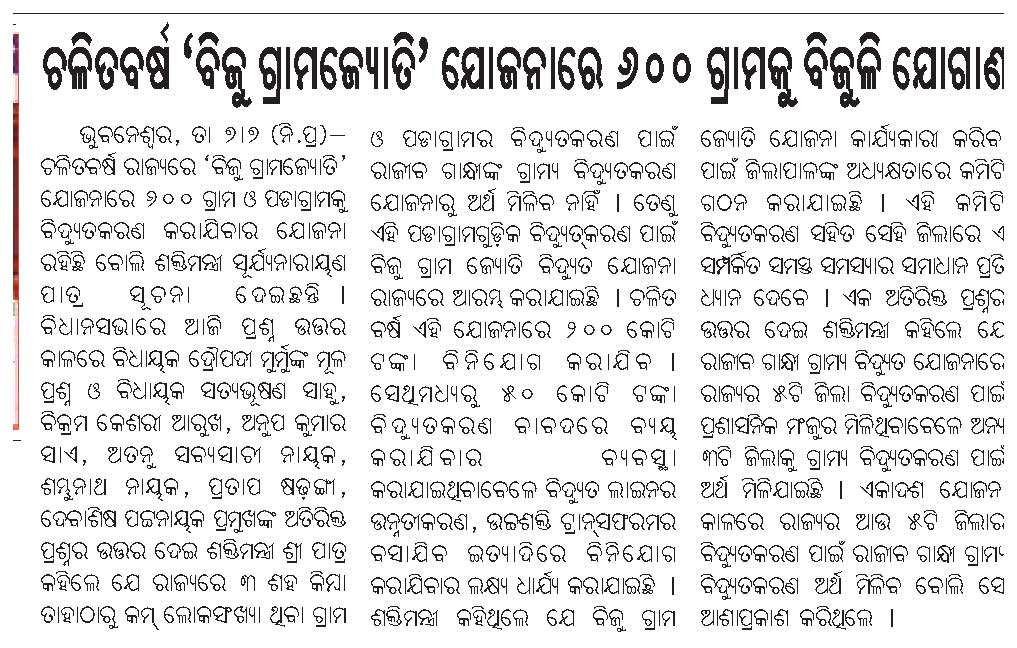Archive for the 'Captive power policy' Category
Orissa government’s new policy regarding thermal power stations
Captive power policy, Odisha govt. action, Thermal Comments Off on Orissa government’s new policy regarding thermal power stationsFollowing is an excerpt from a report in Statesman.
The state government formulated policy guidelines for power generators covering all those who have already signed MoUs and those who are in the pipeline and stipulated availability of power as state shares with the quantum being linked to coal block and coal linkages.
Henceforth the MoUs will have a provision entitling a nominated agency authorised by the state government to purchase 14 per cent power from a generator with coal linkage and 12 per cent power from those without coal linkage. The power purchased from the generator by the state or its authorised agency will be at variable costs determined by the OERC.
For existing power producers, the same has been fixed at seven and five per cent of the generation respectively. However with regards to ultra mega power projects, the state will have a right to purchase upto 50 per cent of power from it through competitive bidding at the lowest bid price only.
The government has also said that ultra mega power projects should contributed five per cent of their profit to the peripheral development fund.
The MoUs and power purchase agreements signed already may be modified and the progress of existing independent power producers will be reviewed, it said.
Ultra mega power projects will signed MoU with the state government for support in getting various clearances and assistance in rehabilitation measures as per state policy.
The central sector power generators will however follow government of India guidelines on sharing of power and state will get 10 per cent home state share from the plant in addition to the 20 per cent share through Gadgil formula.
The Centre will be required for 15 per cent discretionary power from NTPC Kaniha while agreeing to the proposal of NTPC in Ib Valley project, stated the Cabinet.
Power plants in and around Angul
Angul, Anugul- Talcher - Saranga- Nalconagar, Captive power policy, Coal, New Indian Express, Indian Express, Financial express, Thermal 2 Comments »Following is an excerpt from a report in New Indian Express.
… The coal rich Angul district alone shared 8050 mw out of these projected power generation. The figure may go up if Reliance Power Limited and Lanco Power who have also evinced interest to set up power plants, go for it.
Besides, there would be another 1900 mw power generation in the district for captive purposes. The district, virtually, is slated to be the power house not only of State but also of the nation as hardly any district in India would have so much of power generation capacity when these projects would go on stream.
The independent power producers are Jindal photo (2000 mw), Mahanadi Aban Power Limited (1050 mw), Bhusan Power Limited (2000), ESSSAR Power (2000 mw), Tata Sponge (1000 mw). All these are in very infant stages.
While Mahanadi Aban and Jindal photo would get their power plants set up at Talcher, the remaining producers will have their ventures at Angul area.
Besides these, steel producers like Jindal Steel and Power Limited would set up its 900 mw of captive power plant while Monnet Ispat will go for 1000 mw of power plant at Angul.
This would be the additional capacity generation of power in the district in addition to the existing generation capacity of 4500 mw of two NTPC and one Nalco captive power plant.
While at Kaniha, NTPC has 3000 mw super thermal power plant, it has another 460 mw plant at Talcher also. Nalco also has a power plant of installed capacity of 840 mw while another 220 mw addition is under way under the expansion.
Taking into account this current capacity, the total capacity of the district in coming years would be around 14000 mw. If Reliance and Lanco come, this figure will go up further.
Most of these upcoming power producers will have their own captive coal mines. Some of them got allotment while others are waiting.
Angul district unlike others is conducive for power plants because of availabity two key infrastructural bases. These are coal and water.
… but how far the area, already extremely polluted, could sustain such power generation on such a massive scale. Environmentalists fear the Talcher and Angul area which is experiencing 50 degree Celsius in summer could be led to catastrophe unless massive forestations and anti-heating measures are not taken right now on a long term basis.
A concrete environmental management plan should and must be in place along side of these power plants, environmentalists asserted.
FACOR’s expansion plans in Orissa; 2 power plants: New Indian Express
Bhadrakh, Captive power policy, Coal, New Indian Express, Indian Express, Financial express, Thermal Comments Off on FACOR’s expansion plans in Orissa; 2 power plants: New Indian ExpressFollowing is an excerpt from a report in New Indian Express.
Ferro Alloys Corporation Limited (FACOR), one of India’s largest producers and exporters of ferro alloys, is going to expand its integrated plant at a cost of Rs 2,700 cr in Orissa.
The company has initiated an ambitious expansion plan of setting up two power plants and a Stainless Steel Plant (SSP) in Orissa for which a consultancy has also been appointed.
The FACOR group is planning to set up the power plant for its own consumption. A 45 MW coal-based captive power plant is to be set up for Bhadrak near Randia of Orissa at a cost of Rs 180 crore.
The power plant work is scheduled to be completed by 2009 for which the FACOR group has inked a financial tie-up with Rural Electrical Corporation, New Delhi.
Another 250 MW coal-based power plant and a five lakh tpa SSP are also being planned to be set up to the tune of Rs 2,500 crore at Orissa. The expansion works will be completed by 2011.
… According to Ashim, for the Rs 2,500 crore 250 MW power plant and SSP, Rs 1,700 crore would be the debt component while Rs 400 crore would come from internal sources and another Rs 400 crore raised from a partner.
“We are looking for a strategic business partner either in the form of investment or through technological support,” he said.
Rural electrification programs
Angul, Balasore, BGY, Bhadrakh, Biju KBK Yojana, Captive power policy, Checking power theft, Gajapati, Ganjam, Jajpur, MNP, Nayagarha, PMGY, Puri, RGGVY Comments Off on Rural electrification programsNew Indian Express reports on the energy minister’s statement on this in the assembly. Following are some excerpts.
Energy Minister Surya Narayan Patro … announced in the Assembly the Government’s commitment to provide electricity to all villages and hamlets in the State by the end of Eleventh Five Year Plan.
The State Government would formulate a captive power policy (CPP) for the captive power plants, he said. … the Minister said rural electrification is being carried out by the State Government under three schemes – Minimum Needs Programme (MNP), Pradhan Mantri Gramodaya Yojana (PMGY) and Rajiv Gandhi Gramin Vidyutkaran Yojana (RGGVY).
Stating that the Government has submitted the detailed project reports (DPRs) to the Rural Electrification Corporation (REC) for 30 districts, the Minister said the DPRs of Angul, Nayagarh, Ganjam, Gajapati and Jajpur districts have been approved. Besides, the DPRs of three more districts – Balasore, Bhadrak and Puri – have received in-principle approval.
The Minister said the Centre has released Rs 92.85 crore in the first phase to the NTPC and NHPC to take up rural electrification work in Angul, Nayagarh and Ganjam districts.
Referring to the Biju Gramjyoti Yojana (BGY) announced by Chief Minister Naveen Patnaik recently, the Patro said under the programme hamlets with less than 300 population will be electrified. He said the Centre rejected the State Government’s request to include hamlets with less than 300 population in the RGGVY.
The State Government has set a target to provide Rs 1000 crore for the programme in the Eleventh Five Year Plan and provided Rs 50 crore in the 2007-08 financial year. Besides, the State Government has also made a provision of Rs 120 crore under the Biju KBK Yojana for providing electricity, road and drinking water to villages.
The Minister informed the House that the Government has undertaken electrification of 4,499 villages under the MNP for which the Centre has provided Rs 120 crore so far. He said by May-end, 3,736 villages have been electrified under the programme.
Stating that five special police stations have been set up to check theft of power and related crimes, the Minister said special courts have been opened to try these cases.
Patro announced that police stations and courts would be set up in the rest of the districts during the year.
Following is Samaja’s coverage on this.



